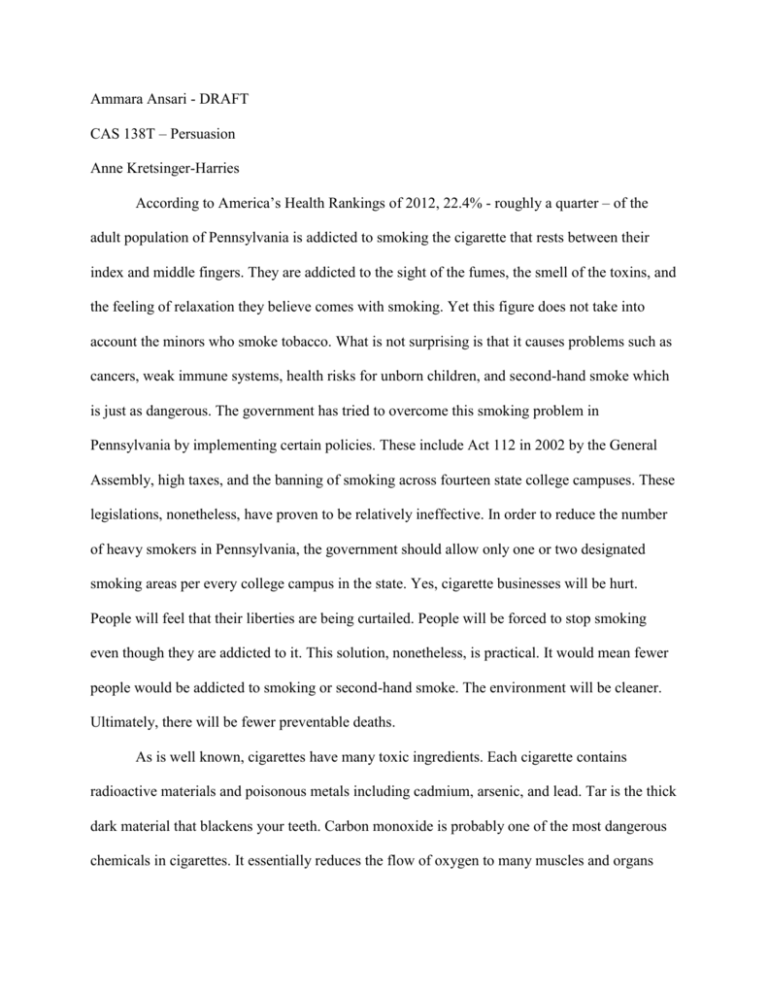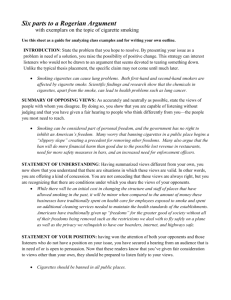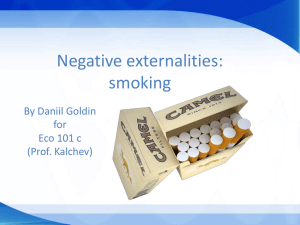Ammara Ansari - DRAFT CAS 138T – Persuasion Anne Kretsinger
advertisement

Ammara Ansari - DRAFT CAS 138T – Persuasion Anne Kretsinger-Harries According to America’s Health Rankings of 2012, 22.4% - roughly a quarter – of the adult population of Pennsylvania is addicted to smoking the cigarette that rests between their index and middle fingers. They are addicted to the sight of the fumes, the smell of the toxins, and the feeling of relaxation they believe comes with smoking. Yet this figure does not take into account the minors who smoke tobacco. What is not surprising is that it causes problems such as cancers, weak immune systems, health risks for unborn children, and second-hand smoke which is just as dangerous. The government has tried to overcome this smoking problem in Pennsylvania by implementing certain policies. These include Act 112 in 2002 by the General Assembly, high taxes, and the banning of smoking across fourteen state college campuses. These legislations, nonetheless, have proven to be relatively ineffective. In order to reduce the number of heavy smokers in Pennsylvania, the government should allow only one or two designated smoking areas per every college campus in the state. Yes, cigarette businesses will be hurt. People will feel that their liberties are being curtailed. People will be forced to stop smoking even though they are addicted to it. This solution, nonetheless, is practical. It would mean fewer people would be addicted to smoking or second-hand smoke. The environment will be cleaner. Ultimately, there will be fewer preventable deaths. As is well known, cigarettes have many toxic ingredients. Each cigarette contains radioactive materials and poisonous metals including cadmium, arsenic, and lead. Tar is the thick dark material that blackens your teeth. Carbon monoxide is probably one of the most dangerous chemicals in cigarettes. It essentially reduces the flow of oxygen to many muscles and organs including the heart and brain. Therefore, the more one smokes, the more chance of facing the risks that are caused by these dangerous chemicals. The toxic materials that go into someone’s body when they smoke cause many health issues. One example is the myriad forms of cancer one may suffer. The Centers for Disease Control and Prevention lists some including leukemia and cancers of the stomach, lung, oral cavity, pancreas, kidney, and bladder. Moreover, smoking reduces the effectiveness of the immune system and it takes longer for smokers who get sick to recover from their illnesses. Gum disease is rampant and wrinkling before old age is common. Pregnant women who smoke are more likely to face the suffering that comes with miscarriages, stillbirths, and premature children. There is also a greater likelihood that the child will have a low birth weight, which can in turn affect growth and lead to many physical health issues. However, one must also remember that smoking does not affect only smokers. Those who are prone to second-hand smoke also face many health problems. Second-hand smoke also affects unborn children. It also causes many of the same types of cancers as regular smoking. Furthermore, the American Cancer Society mentions that those children who are asthmatic can incur further breathing problems. The state of Pennsylvania has implemented certain legislation in order to reduce the number of heavy smokers. However, these policies have proven to be ineffective. For example, in 2002, Pennsylvania passed Act 112. It prohibited the selling or “furnishing” of tobacco through any means to minors (those who are below eighteen years of age). Those who provide minors with tobacco can be charged with serious fines. For instance, first time offenders have to pay fines between one hundred and two hundred and fifty dollars. At a first glance, this policy might seem to ensure that future generations will not be taken in by the fumes. But reality dictates otherwise. The Pennsylvania Department of Health conducts Youth Tobacco Surveys around every year and then issues an Executive Summary. In the Summary for the 2008/2009 school year, “when asked how long they can go before feeling the need for a cigarette, 32 percent…of middle school students who smoke and 46 percent…of high school smokers answered “a day or less” (Penn. Dept. of Health). This is approximately six or seven years after the enactment of Act 112. This means that there are definitely ways that minors could be acquiring cigarettes. The first is through the sellers themselves who are breaking the law for the purpose of gaining more revenue. Another could be that those who are eighteen or over buy cigarettes for their family or friends who are minors. This means that minors are still able to obtain cigarettes even though this policy was meant to prevent exactly that. This, nonetheless, is not the only policy that has proven to be unsuccessful. Pennsylvania’s tax laws aim at making it difficult for smokers to pay for cigarette packs. According to the Pennsylvania Department of Revenue, “the tax rate is $1.60 per pack of 20 cigarettes ($0.08 per stick), or $16 per carton of 10 packs”. On top of that, there are additional sales and use taxes on the purchase of cigarette packs. So for a person who consumed a pack of cigarettes per day, it would cost quite a lot. The whole point for this tax was to make people think twice before they bought another pack. It is what one would consider a sin tax. One must consider if this policy actually works, especially for those who are heavy smokers. It turns out that the answer is no. Simple economic principles indicate that tobacco or cigarettes are what one would call inelastic goods. This means that no matter how high the prices increase, people will keep buying cigarettes because they feel they have the need for them. This is comparable to medicine whose demand is also inelastic. Whatever the price of the medicine, a patient would need to buy the drugs to cure his illnesses or health issues. This indicates that increasing the prices on taxes does not necessarily mean that people will immediately stop buying them. Those who are full-time smokers will find it extremely hard to quit and quite often they will be willing to pay the extra price. Apart from the initiation of Act 112 and the implementation of cigarette taxes, Pennsylvania has banned smoking across 14 different state campuses. It seems that this would allow for greater smoke-free environment within the state. One extra look into the demographics, however, can prove that this ban was definitely not enough. There are a total of 3,292 state owned stools throughout Pennsylvania and a total of around 1,785,993 people attend these schools. This means that there were still 3,278 schools that had not banned smoking across college campuses. Also, because of the spontaneity of the ban, it was eventually revoked. All fourteen colleges now allow smoking across campus (except inside buildings and living areas). Students and faculty felt that the government should not have banned smoking without negotiation. The ban also did not allow any designated smoking areas. Those who were addicted to cigarettes did not have even the slightest opportunity to smoke even once during the day.






